South Bend, Indiana, Hgh State Clinic, Hgh Injections, Hrt Doctors
South Bend, Indiana Blood Testing Facilities
 Represents a LabCorp blood testing facility
Represents a LabCorp blood testing facility Represents a Quest Diagnostics blood testing facility
Represents a Quest Diagnostics blood testing facility

Nearby Labcorp Blood Testing facilities:
- Labcorp Center Distance: 3 m, 3515 N Main St. Ste 2, Mishawaka, St Joseph County, IN, 46545
- Labcorp Center Distance: 42 m, 880 Eastport Centre 2Nd Floor, Valparaiso, Porter County, IN, 46383
- Labcorp Center Distance: 53 m, 9150 E 109Th Ave Ste C-1, Crown Point, Lake County, IN, 46307
- Labcorp Center Distance: 57 m, 387 East 84Th Dr, Merrillville, Lake County, IN, 46410
- Labcorp Center Distance: 64 m, 3250 Intertech Dr Ste C, Angola, Steuben County, IN, 46703
- Labcorp Center Distance: 68 m, 10020 Dupont Circle, Fort Wayne, Allen County, IN, 46825
- Labcorp Center Distance: 69 m, 6033 N. Clinton St, Fort Wayne, Allen County, IN, 46825
- Labcorp Center Distance: 71 m, 6404 Rothman Rd, Fort Wayne, Allen County, IN, 46835
- Labcorp Center Distance: 72 m, 111 N. Wabash Avenue Ste 1710, Chicago, Cook County, IL, 60602
- Labcorp Center Distance: 79 m, 16325 Harlem Ave Ste 110, Tinley Park, Cook County, IL, 60477
- Labcorp Center Distance: 81 m, 1127 N Western Ave, Marion, Grant County, IN, 46952
- Labcorp Center Distance: 83 m, 6191 N Canfield Ave, Chicago, Cook County, IL, 60631
- Labcorp Center Distance: 84 m, 10737 W. 165Th Street, Orland Park, Cook County, IL, 60467
- Labcorp Center Distance: 85 m, 3803 Southland Ave, Kokomo, Howard County, IN, 46902
- Labcorp Center Distance: 87 m, 522 W Chestnut Street, Hinsdale, Dupage County, IL, 60521
- Labcorp Center Distance: 91 m, 955 High St, Decatur, Adams County, IN, 46733
- Labcorp Center Distance: 94 m, 1155 E Paris Se Suite 200, Grand Rapids, Kent County, MI, 49546
- Labcorp Center Distance: 95 m, 2025 S. Chicago Street, Joliet, Will County, IL, 60436
- Labcorp Center Distance: 96 m, 35 Tower Ct Ste E, Gurnee, Lake County, IL, 60031
- Labcorp Center Distance: 97 m, 330 North Madison Ste B2, Joliet, Will County, IL, 60435
Nearby Quest Blood Testing facilities:
- Quest Center Distance: 4 m, 16597 State Road 23, South Bend, St Joseph County, IN, 46635-1461
- Quest Center Distance: 29 m, 2500 Niles Rd, Saint Joseph, Berrien County, MI, 49085-3272
- Quest Center Distance: 42 m, 813 N. Porter Campus Dr, Valparaiso, Porter County, IN, 46383-8947
- Quest Center Distance: 58 m, 119 E 93Rd Ave, Crown Point, Lake County, IN, 46307-8601
- Quest Center Distance: 65 m, 8840 Calumet Ave, Munster, Lake County, IN, 46321-2546
- Quest Center Distance: 67 m, 17665 Torrence Ave, Lansing, Cook County, IL, 60438-4839
- Quest Center Distance: 69 m, 8751 S Greenwood Ave, Chicago, Cook County, IL, 60619-7018
- Quest Center Distance: 72 m, 111 N Wabash Ave, Chicago, Cook County, IL, 60602-3063
- Quest Center Distance: 73 m, 1460 N Halsted St, Chicago, Cook County, IL, 60642-2605
- Quest Center Distance: 74 m, 3000 N Halsted, Chicago, Cook County, IL, 60657-5188
- Quest Center Distance: 75 m, 19150 South Kedzie Ave, Flossmoor, Cook County, IL, 60422-0001
- Quest Center Distance: 76 m, 10837 S Cicero Ave, Oak Lawn, Cook County, IL, 60453-6458
- Quest Center Distance: 77 m, 800 Austin St, Evanston, Cook County, IL, 60202-3439
- Quest Center Distance: 79 m, 4126 N Milwaukee Ave, Chicago, Cook County, IL, 60641-1860
- Quest Center Distance: 80 m, 4801 W Peterson Ave, Chicago, Cook County, IL, 60646-5725
- Quest Center Distance: 81 m, 4709 W Golf, Skokie, Cook County, IL, 60076-1258
- Quest Center Distance: 82 m, 9046 W 159Th St, Orland Park, Cook County, IL, 60462-5646
- Quest Center Distance: 83 m, 19070 Everett Blvd, Mokena, Will County, IL, 60448-2073
- Quest Center Distance: 85 m, 1600 Dempster St, Park Ridge, Cook County, IL, 60068-1172
- Quest Center Distance: 86 m, 4763 Wilson Ave Sw, Grandville, Kent County, MI, 49418-9015
- Quest Center Distance: 87 m, 534 Chestnut St, Hinsdale, Dupage County, IL, 60521-3175
- Quest Center Distance: 88 m, 201 E. High St, Bryan, Williams County, OH, 43506-0000
- Quest Center Distance: 90 m, 1113 Fairview Ave, Westmont, Dupage County, IL, 60559-2709
- Quest Center Distance: 91 m, 175 E Bethel Dr, Bourbonnais, Kankakee County, IL, 60914-1456
- Quest Center Distance: 92 m, 1450 Busch Pkwy, Buffalo Grove, Lake County, IL, 60089-4541
- Quest Center Distance: 93 m, 1100 W Central Rd, Arlington Heights, Cook County, IL, 60005-2402
- Quest Center Distance: 94 m, 484 W Boughton Rd, Bolingbrook, Will County, IL, 60440-2398
- Quest Center Distance: 95 m, 565 Lakeview Pkwy, Vernon Hills, Lake County, IL, 60061-1839
- Quest Center Distance: 96 m, 15 Tower Ct, Gurnee, Lake County, IL, 60031-5708
- Quest Center Distance: 97 m, 310 N Hammes Ave, Joliet, Will County, IL, 60435-5676
- Quest Center Distance: 98 m, 640 S Washington St, Naperville, Dupage County, IL, 60540-6693
Indiana Hormone Replacement Therapy Services
The 21st century is a period of blisteringly fast medical and biotechnological innovation. Medical treatments derived from Recombinant-DNA technology are at the forefront of this new era of medicine, and medical researchers are finding new benefits for Bio-Identical Hormone Replacement Therapy every day.
At the Conscious Evolution Institute, we make it our mission to remain at the cusp of this new era, and provide the latest and greatest forms of Hormone Restoration to our clients all across the state of Indiana and all across the nation. All it takes to find out if you qualify is a brief medical examination with one of our regional affiliates, and a simple blood sample. If you qualify for any of the HRT Solutions that we provide, we can have the treatment shipped directly to your home within a matter of days!
Indiana Andropause Therapy
Advertisements heard on the radio and seen on television and online are increasing public awareness for Testosterone Deficiency, but did you know that Low-T is more than just a sexual disorder?
Advertisements tend to emphasize the sexual issues related to Testosterone Deficiency, such as low libido and erectile dysfunction, but Age-Related Low-T (also known as Testosterone Deficiency), is associated with a number of different issues that can exacerbate the aging process and reduce your health and wellness, including diabetes, heart disease, and osteoporosis.
Our physicians will help you fully recognize the effects of Low-T and help you choose a treatment that works for your health as well as your budget.
Indiana Human Growth Hormone HRT
Another fantastic service we provide is HGH Hormone Replacement Therapy. Human Growth Hormone Injections are indicated for the treatment of Adult HGH Deficiency, and we provide HGH Treatments to men and women 30 and over his display a real clinical need for treatment.
Age-Related HGH Deficiency is also known as Somatopause, and is associated with a number of symptoms related both to aging and premature aging, including weakening metabolism, loss of muscle density, sleep disorders, cholesterol imbalance, fatigue, diminished healing capacity, and suppressed immune response. Our Bio-Identical HGH Injections get to the source of the problem, replacing the precious Hormone Balance that your body is no longer able to sustain.
We also offer an alternative form of therapy to Indiana residents, known as Sermorelin Acetate. Sermorelin Acetate is scientifically proven to naturally boost the pituitary secretion of HGH with no risk of overdose. Call us today if you'd like to find out how to buy Sermorelin Acetate or buy HGH for your own personal health use.
Indiana HCG Diet
If you are obese or simply chronically overweight and are looking for a highly effective means to shed those excess pounds, we suggest our clinically proven and effective Recombinant HCG Diet. Many people struggle with obesity because they are unable to overcome the misery associated with the hunger and cravings that overwhelm them during dieting.
Bio-Identical HCG Injections have the special capability to actually quieten the feelings of hunger normally associated with dieting while also speeding up the rate of fat metabolism and preventing feelings of tiredness and fatigue. When combined with a special low-calorie meal plan, HCG Injections can help you lose as much as a pound each and every day!
Major Cities in Indiana
Indianapolis
Indianapolis is the most highly populated city in the state of Indiana, and is also the capital of the state. The economy of Indianapolis revolves around three primary fields: Finance, Health Care, and Education.
Indiana is home to a number of sports landmarks, including Indianapolis Motor Speedway and Lucas Oil Stadium. Indiana also has a number of professional sports teams, including the Indianapolis Pacers and the Indianapolis Colts. Indianapolis is well-known for its athletic history, and is frequently referred to both as The Racing Capital of the World and The Amateur Sports Capital of the World. Indianapolis is also home to NCAA Headquarters.
Fort Wayne
Fort Wayne is located in Northeast Indiana, and is the second most populous city in the state. Fort Wayne is considered to be one of the cultural centers of the state, and is home to a number of parks and museums. Among the museums located in Fort Wayne are the Karpeles Manuscript Library Museum, the Fort Wayne Firefighters Museum, and the Fort Wayne Museum of Art.
Historically, Fort Wayne was a manufacturing city, and the city still retains a strong industrial presence. Today, the economy has grown and diversified, and has developed around a growing military economy. Raytheon, ITT Exelis, and BAE Systems are all located in the area. Among the largest employers in the city are General Motors, Lutheran Health Network, and Parkview Health System.
Evansville
Evansville, Indiana is located in the southwestern corner of the state and is the 3rd most populous city in the state. Two universities are located in Evansville: The University of Southern Indiana and the University of Evansville. Evansville is considered one of the most livable cities in the country by many polls.
Due to its location and its history of being a multifaceted economy, Evansville has a steady and stable supply of work. A number of companies call Evansville home, including Shoe Carnival, Old National Bank, Koch Enterprises, and Accuride.
South Bend
South Bend is situated in north-central Indiana and is located within a short distance of the Michigan border. South Bend is most notable as the home of Notre Dame University. The city got its name because it is located on the southernmost bend of the St. Joseph River. The strongest sectors of the South Bend economy are tourism, education, and health care. Some corporations based in South Bend are AM General, Honeywell, and Crowe Horwath.
Carmel
Carmel Indiana is a suburb of Indianapolis located immediately to its north. It is the largest suburb of the metro area, and is the fifth most populous city in the state. Carmel is frequently listed among the most ideal cities to live in the United States. Because of its proximity to Indianapolis and its high quality of life, Carmel continues to grow. Companies based in Carmel include ITT Technical Institute, MISO, and CNO Financial Group.
All About South Bend, Indiana Geographic Area
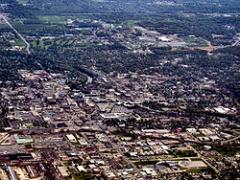

The city of South Bend is the county seat of St. Joseph County, Indiana, United States, on the St. Joseph River near its southernmost bend, from which it derives its name. As of the 2010 United States Census, the city had a total of 101,168 residents; its Metropolitan Statistical Area had a population of 316,663 and Combined Statistical Area of 544,582. It is the fourth largest city in Indiana and the economic and cultural hub of the Michiana region, with the University of Notre Dame located just to the north in unincorporated Notre Dame, Indiana.
The area was originally settled in the early 18th century by fur traders, and established as a city in 1865. The St. Joseph River shaped South Bend's economy through the mid-20th century. River access assisted heavy industrial development such as that of the Studebaker Corporation, the Oliver Chilled Plow Company, and other large corporations.
The population of South Bend has declined since a peak of 132,445 in 1960, chiefly due to the demise of Studebaker and other heavy industry. The 2000 U.S. Census recorded a population increase of 2.2% from 1990, the first since 1960. Today, the largest industries in South Bend are health care, education, small business, and tourism. Remaining large corporations include Crowe Horwath, Honeywell, and AM General.
The earliest European settlements in the area were fur trading posts. In 1820, Pierre Frieschutz Navarre arrived, representing the American Fur Company (AFC) of John Jacob Astor. He settled near what is now downtown South Bend. Alexis Coquillard, another agent of the AFC, passed through South Bend in 1823 and returned in 1824 with his family to make it his home. At the time, the post was known as Big St. Joseph Station. In 1827, Lathrop Minor Taylor established a post for Samuel Hanna and Company, in whose records the name St. Joseph's, Indiana was used. By 1829, the town was growing, with Coquillard and Taylor emerging as leaders. They applied for a post office. Taylor was appointed postmaster, and the post office was designated as Southold, Allen County, Indiana. The following year, the name was changed to South Bend, probably to ease confusion, as several other communities were named Southold at the time.
In 1831, South Bend was laid out as the county seat and as one of the four original townships of St. Joseph County. Soon after, design began on what would become the town of South Bend. The town was formally established in 1835 and rapidly grew. In 1856, attorney Andrew Anderson founded May Oberfell Lorber, the oldest business in St. Joseph County. He compiled a complete index of South Bend aos real estate records.
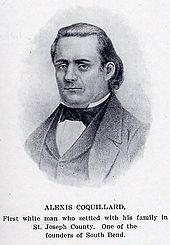
During the late 1830s through the 1850s, much of South Bend's development centered on the industrial complex of factories located on the two races (man-made canals along the St. Joseph River in South Bend). Several dams were created, and mills were built on each side of the river. On October 4, 1851, the first steam locomotive entered South Bend. This led to a general shift of businesses from the river toward the railroad. In 1852, Henry Studebaker set up a wagon shop in South Bend. Studebaker became the world's largest wagon builder and the only one to later succeed as an automobile manufacturer. The Singer Sewing Company and the Oliver Chilled Plow Company were among other companies that made manufacturing the driving force in the South Bend economy until the mid-20th century.
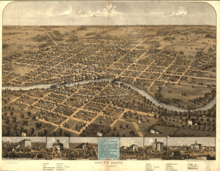
South Bend benefited from its location on the Michigan Road, the main north aesouth artery of northern Indiana in the 19th century. Another significant development occurred near South Bend in 1842, when Father Edward Sorin founded the University of Notre Dame just north of the town. It became a major factor in the area's economy and culture. In 1865, South Bend was incorporated as a city, and its first elections were held on June 5, 1865.
Other industries developed in South Bend in the early 20th century, including Birdsell Manufacturing Company, the Bendix Corporation, Honeywell, AlliedSignal, South Bend Lathe Works, the O'Brien Paint Corp., and the South Bend Toy Company. Fast development led to the creation of electric rail transportation throughout the area and, in 1925, the South Shore interurban streetcar service was established from downtown South Bend to downtown Chicago.
On June 30, 1934, the Merchants National Bank in South Bend was the last bank to be robbed by the notorious "Dillinger gang".
By 1950, more than half of all employment was in the manufacturing sector. Due to economic difficulties, Studebaker closed its automotive manufacturing plants in South Bend in December 1963. A general decline in manufacturing soon followed as industry was being restructured nationwide. By the year 2000, manufacturing was only 16% of the local economy. Due to the severe loss of jobs, the city's population decreased by nearly 30,000 during that period.
In 1984, South Bend community leaders began seeking a minor league baseball team for the city. A stadium was constructed in 1986 and a 10 year player development contract was signed with the Chicago White Sox. The team would be known as the South Bend White Sox. In 1994, the team's name was changed to the South Bend Silver Hawks. The Silver Hawks are a Class A minor league affiliate of the Arizona Diamondbacks in the Midwest League.
South Bend is located at 41 °40 a²21 a³N 86 °15 a²19 a³W / 41.6725 °N 86.25528 °W / 41.6725; -86.25528 (41.672597, -86.255157), 5 miles (8 km) from the Michigan border and approximately equidistant from Illinois and Ohio. The city is 93 miles (150 km) from Chicago. The nearest shore of Lake Michigan is 20 miles (32 km) away.
According to the 2010 U.S. Census, the city has a total area of 41.88 square miles (108.5 km2), of which 41.46 square miles (107.4 km2), or 99%, is land and 0.42 square miles (1.1 km2), or 1%, is water.
The St. Joseph River flows from the east end of the city turning north near the city center, giving South Bend its name at the bend in the river. South Bend is located on the North-South continental divide, and the river flows northwest into Lake Michigan. The downtown area is located in the north central part of the city along the St. Joseph River. Notre Dame, Indiana, is directly adjacent to the north. The city extends further north on the west side, mainly with manufacturing and distribution facilities near the South Bend Regional Airport. Mishawaka, Indiana, is adjacent to South Bend's east side.
South Bend has a humid continental climate, with a Koppen climate classification of Dfa. Lake Michigan has a large effect on the climate of South Bend, including lake effect snow in winter and moderating temperatures year round. June through August are the warmest months, with average temperatures above 80 °F (27 °C). Normally, 42 days with thunderstorms occur each year. The snowiest month is usually January, with snow fall normally recorded from October through April. On average South Bend receives 81.8 inches (208 cm) of snow per year. Spring and fall can be mild and overcast, but also severely stormy at times with 293 partly cloudy to cloudy days each year.
As of the 2000 U.S. Census there were 107,789 people, 42,908 households, and 25,959 families residing in the city. The population density was 2,786.4 people per square mile (1,075.9/km ²). There were 46,349 housing units at an average density of 1,198.1 per square mile (462.7/km ²). The racial makeup of the city was 66.1% White, 24.6% African American, 0.4% Native American, 1.2% Asian, 0.1% Pacific Islander, 4.9% from other races, and 2.8% from two or more races. Hispanic or Latino of any race were 8.5% of the population.
Ancestries: Germans (17.4%), Polish (10.6%), Irish (10.5%), English (5.8%), United States (3.9%), Hungarian (3.3%) (U.S. Census).
There were 42,908 households out of which 30.5% had children under the age of 18 living with them, 39.0% were married couples living together, 17.0% had a female householder with no husband present, and 39.5% were non-families. Of all households, 32.5% were made up of individuals and 12.7% had someone living alone who was 65 years of age or older. The average household size was 2.45 and the average family size was 3.12.
The city's population was distributed across all age groups, with 27.3% under the age of 18, 10.4% from 18 to 24, 29.3% from 25 to 44, 18.2% from 45 to 64, and 14.8% who were 65 years of age or older. The median age was 33 years. For every 100 females there were 91.1 males. For every 100 females age 18 and over, there were 86.7 males.
The median income for a household in the city was $32,439, and the median income for a family was $39,046. Males had a median income of $31,958 versus $23,744 for females. The per capita income for the city was $17,121. About 13.6% of families and 16.7% of the population were below the poverty line, including 24.0% of those under age 18 and 9.1% of those age 65 or over.
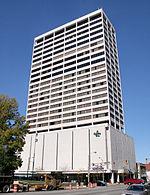
South Bend's location on the St. Joseph River led to an industrial-based economy in the late 19th century and early-to-mid-20th century. In 1923, industrialist and entrepreneur Vincent H. Bendix selected South Bend as the site of his new manufacturing plant for automotive parts. He chose South Bend primarily because it was on a rail line midway between Chicago and Detroit, the two automotive manufacturing centers of the United States at the time. Eventually, the Bendix corporation would build a vast manufacturing complex on its South Bend acreage served by the major railroads, including a huge shipping and receiving building where railroad cars could enter at one end, unload, and depart at the opposite end.
By the end of World War II that economy began to diminish. The Studebaker plant, which had been one of the city's largest industrial employers, closed in 1963; its engine block plant shuttered the following year. Parts of the Bendix factory complex were later acquired and subdivided between Honeywell Corporation and Bosch Corporation respectively. Honeywell Aerospace continues to manufacture aviation products at its former Bendix facility. In 2010, Bosch announced that it will cease all operations at its Bendix plant location in South Bend by the end of 2011.
These and other remnants of the old economy can still be seen in the abandoned industrial buildings around the city, most of which have not been reclaimed, though a number have been demolished. Since the 1960s, education, health care, and small business have come to the forefront of South Bend's economy, though the city has never regained the level of prosperity it enjoyed before that time. Large swaths of housing ae7.4% of the city's housing stock in 2006 aeremain vacant.
Nearby University of Notre Dame is a large contributor to the local economy. The university is the largest employer in St. Joseph County, employing 4,758 people.
Health care is another major contributor to the South Bend economy. Memorial Health System is the largest employer in the city. In 2012, Memorial announced that it was merging with Elkhart General Hospital, located in Elkhart County, to form Beacon Health System. Other notable businesses include Honeywell, Bosch, Woodwind & Brasswind, and PEI Genesis. AM General, Crowe Horwath, Martin's Super Markets, and Schurz Communications have corporate headquarters in South Bend.
Efforts are underway to spur economic growth in South Bend. The St. Joe Valley Metronet is a not-for-profit organization attempting to create a more robust telecommunications infrastructure capable of inexpensive high-speed data transmission. It is thought this could bring more high tech firms to the city and surrounding area. Redevelopment is underway for some of the abandoned industrial facilities, with the abandoned Oliver Corporation buildings being the most recent example of reclaimed property.
In 2012 Kiplinger's Personal Finance ranked South Bend eight of the "Ten Best Cities for Cheapskates".
According to the 2010 Comprehensive Annual Financial Report, the city's top employers are:
South Bend was influenced by a large influx of Polish Catholic immigrants in the late 19th century. Dyngus Day is widely celebrated on the Monday after Easter and is known locally to be the beginning of the city elections campaign season. Fat Tuesday is also celebrated in South Bend, with paczkis being a staple food product in the city for the day. The city and surrounding county have 23 Catholic churches and 11 Catholic schools. Three Catholic universities: the University of Notre Dame, Holy Cross College, and Saint Mary's College, are located in the adjacent city of Notre Dame.
The city has several annual festivals. The South Bend Reggae Music Festival showcases some the world's premier international reggae artists every summer. Proceeds from the festival are given to the Pangani Foundation of South Bend, which provides medical supplies to hospitals in Malawi. WBYT FM - B100 (Country Station) hosts an Annual All Day Country Concert, with over 37,000 free tickets in early September.
The World Pulse Festival, broadcast by LeSEA Broadcasting network, is held annually in South Bend. The event is an annual Contemporary Christian music festival, attracting more than 50,000 visitors each year.
The South Bend Museum of Art is located in the Century Center in downtown South Bend. The museum was opened to the public in March 1996, and features a variety of artists from South Bend and the Michiana region. Currently, over 850 works are featured in the permanent collection. The museum also offers several classes and workshops for adults and children.
The Northern Indiana Center for History is the headquarters of the Northern Indiana Historical Society, the second oldest historical society in Indiana, which was established in 1867 to collect and interpret the history of the northern Indiana region by St. Joseph County's leading citizens. Copshaholm is one of the central features of the Center for History. The 38-room mansion was built in 1895 and is currently listed in the National Register of Historic Places. The home was built by Joseph Doty Oliver, the son of James Oliver, the founder of the Oliver Farm Equipment Company, once the largest plow manufacturer in the United States. The history museum occupies several buildings and includes areas dedicated to the history of the St. Joseph River Valley, the University of Notre Dame, the All-American Girls Professional Baseball League, and the Kidsfirst Children's Museum.
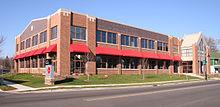
The Studebaker National Museum holds a large collection of wagons and automobiles from the 150 year production history of the Studebaker Corporation. The museum began as a collection of wagons and automobiles produced by Studebaker, including the presidential carriages of Lincoln, McKinley, Harrison, and Grant. The company donated the collection to the city of South Bend in 1966. The collection was housed in various locations from the Century Center to its current location in downtown South Bend, adjacent to the Northern Indiana Center for History. The two museums share one campus, and together form The Museums at Washington and Chapin. The former South Bend mansion of Clement Studebaker, named Tippecanoe Place, is now a restaurant.
The Morris Performing Arts Center, built in 1922, included the Palace Theater, a venue for vaudeville. The theatre's heyday was in 1940 with the premiere of Knute Rockne, All American starring Ronald Reagan. A crowd estimated at 24,000 gathered outside. The theater was scheduled for demolition in 1959, when E. M. Morris purchased the facility and sold it to the city for one dollar, after which it was renamed the Morris Civic Auditorium. A total renovation was completed in 2000. The Morris Performing Arts Center also includes the Palais Royale Ballroom, on which restoration was recently completed. The center houses the Broadway Theater League and the South Bend Symphony Orchestra. The orchestra's Shanghai-born conductor Tsung Yeh was the first conductor ever to hold music directorships of both a western symphony orchestra and a major Chinese orchestra.
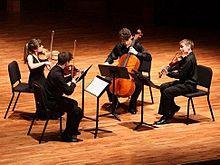
The Fischoff National Chamber Music Association, sponsor of the world's largest chamber music competition, was founded in South Bend in 1973. The annual Fischoff National Chamber Music Competition is held on the campus of the University of Notre Dame.
The South Bend Civic Theatre, founded in 1957, was for many years located at The Firehouse, 701 Portage Avenue. In 2007, a new theatre opened at 403 North Main Street, in what was formerly the Scottish Rite Building. The new facility includes a 209-seat main-stage auditorium and a 90-seat "black-box" studio theatre. The South Bend Civic Theatre produces more than a dozen plays per year, including several productions in its Family Series.
Schuyler Colfax, the 17th Vice President of the United States, is interred in South Bend City Cemetery.
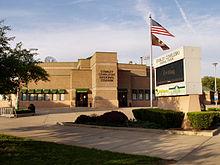
During World War II, the South Bend Blue Sox All-American Girls Professional Baseball League team was formed in the city. The team participated in all the league's seasons from 1943 to 1954.
The Notre Dame Fighting Irish provide much of the sports action for the South Bend locale. Football Saturdays have become a major event for the city, attracting fans who come to watch the game and have tailgate parties. Notre Dame basketball games are also popular, along with the other university sports. The College Football Hall of Fame was moved from Kings Mill, Ohio, to downtown South Bend in 1995.
The city has the South Bend Silver Hawks, a Class A Minor League Baseball team, who plays at Coveleski Stadium in downtown South Bend. In 2005 the franchise nearly moved to Marion, Illinois, but a group of investors, led by former Indiana Governor and South Bend Mayor Joe Kernan, bought the Silver Hawks in order to ensure the team stayed in South Bend.
The city also hosts the South Bend Roller Girls, the city's non-profit flat track roller derby league. Founded in March 2010, the league has worked to support fundraising for local charities, such as the Salvation Army's Adopt-A-Family program, the American Cancer Society's Making Strides Against Breast Cancer, and the St. Joe County Humane Society. The South Bend Roller Girls traveling/competitive team, The Studebreakers, is named after the historic Studebaker Corporation. The team is a Women's Flat Track Derby Association Apprentice.
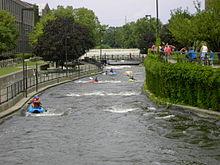
The Potawatomi Zoo opened in 1902 and is the oldest in the state. It features more than 400 animals in its 23 acres (93,000 m2). The zoo is run by the South Bend Parks and Recreation Department. Along with the zoo, the South Bend Parks and Recreation department operates over 50 parks, golf courses, and recreational areas throughout the city.
Near the Potawatomi Zoo are the Potawatomi Greenhouses and the Ella Morris and Muessel-Ellison Botanical Conservatories. The greenhouses were originally constructed in the 1920s, with the conservatories added in the 1960s. In 2007 the greenhouses and conservatories were in danger of closing due to increased operating costs, but a campaign by the Botanical Society of South Bend was able to raise funds to keep the facilities operating.
The city is home to the East Race Waterway, which is used for boating and water sports.
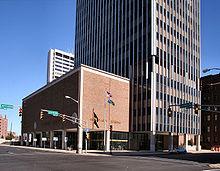
South Bend government follows the mayor-council representative model of municipal government and operates out of the County-City Building in downtown South Bend. The St. Joseph county government also operates at this facility.
The government of South Bend is led by the office of the mayor, who is elected to a four-year term and acts as chief executive for the city government. The current mayor is Pete Buttigieg.
The legislative branch of the South Bend government is the city council. The council is composed of nine members, each elected to a four-year term. South Bend is divided into six districts, with each district electing one council member. The final three members are elected at-large. Under Indiana law, the council may pass resolutions and ordinances. Resolutions relate to internal council procedures, while ordinances address city municipal codes.
The final elected member of the South Bend government is the City Clerk, who is responsible for maintaining official city records and providing general clerical assistance to the City Council.
Michael A. Dvorak is the Prosecuting Attorney for the 60th Judicial Circuit, which consists of St. Joseph County. He was first elected in 2002.
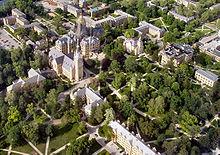
The South Bend area is home to several institutions of higher learning, the most famous of which is the University of Notre Dame. Located to the north of South Bend in Notre Dame, Indiana, the University of Notre Dame was founded in 1842 by Father Edward Sorin, a French priest, before South Bend was incorporated as a city in 1865. It has been an intrinsic part of the South Bend area with great effect on its culture and economy. Saint Mary's College and Holy Cross College are both located near Notre Dame, just north of South Bend.
Indiana University South Bend is the third largest campus in the Indiana University system. Enrollment in Fall 2008 was 7,712. Early reports for the Fall 2009 enrollment was estimated at over 8,200 students. Other universities with campuses in South Bend include Brown Mackie College, Ivy Tech Community College of Indiana, and Purdue University.
Public schools in South Bend are operated by the South Bend Community School Corporation. The corporation runs 17 primary centers (grades K-4), nine intermediate centers (grades 5-8), and four high schools, serving over 22,000 students as of 2006.
The Diocese of Fort Wayne-South Bend operates eleven private Catholic schools in South Bend.
South Bend is also home to Veritas Academy, Indiana's first charter school. A second charter school opened in Fall 2009, founded by the Indiana Schools of Excellence Foundation. Another charter school was slated to open in 2011.
There are also several private schools: Trinity School at Greenlawn, recipient of three Blue Ribbon Awards from the U.S. Department of Education, and Stanley Clark Elementary School, a recipient of one award.
One major daily newspaper serves the South Bend Metro area, the South Bend Tribune. It is distributed throughout the Michiana region and publishes five editions including a Metro edition, a Mishawaka edition, a Michigan edition, a Penn-Harris-Madison East edition, and a Marshall edition. The South Bend Tribune along with WSBT-TV is owned by Schurz Communications, a South Bend corporation that owns and operates 42 newspaper publications and television stations nationwide.
South Bend has a wide variety of local radio broadcast available in the area. Stations' programming content contains a wide variety including public radio, classical music, religious, country, and urban contemporary among others. For more information, see List of radio stations in Indiana.
As of 2008, the South Bend-Elkhart designated market area is the 89th largest in the United States, with 334,370 homes (0.3% of the U.S. population). Most of the major television networks have affiliates in the Michiana area.
Television stations located in South Bend include WNDU-TV (NBC), WNIT-TV (PBS) and WHME-TV (LeSEA). Stations located in nearby Mishawaka include WSBT-TV (CBS), WBND-LP (ABC), WCWW-LP (CW) and WMYS-LP (My Network TV). WSJV (Fox) also broadcasts in the Michiana area from Elkart.
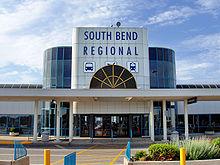
South Bend's location around the St. Joseph River has influenced the development of its streets. While city streets mainly follow a grid layout, road development also adapted to the river's path. South Bend is connected to state and national highway systems by Indiana State Road 2, 23, and 933; U.S. Route 20 and 31; and Interstate 80 and 90, the Indiana Toll Road. Original routes of both the Lincoln Highway and the Dixie Highway also pass through South Bend. The headquarters for the Lincoln Highway Association are in South Bend.
For transportation around the South Bend metro area, the St. Joseph Valley Parkway, constructed between 1960 and 1990, connects Benton Harbor, Michigan, to South Bend, Mishawaka, and Elkhart, Indiana. While segments are designated as U.S. 20, U.S. 31, and Indiana State Road 331, it is simply referred to locally as "the bypass". The Indiana Toll Road (Interstates 80 and 90) passes through northern South Bend.
Public transportation in South Bend is controlled by TRANSPO (South Bend Public Transportation Corporation). TRANSPO operates bus routes between stations located in South Bend and Mishawaka as well as provides services to the towns of Osceola and Roseland, from Monday through Saturday. In 2006, the TRANSPO fleet switched to Bio-diesel fuel.
South Bend serves as the transportation hub for Michiana. The South Bend Regional Airport lies off of U.S. 31 and the Indiana Toll Road in the northwest corner of South Bend. The airport connects South Bend to larger hubs including Atlanta, Chicago O'Hare, Cincinnati, Cleveland, Detroit, Las Vegas, Minneapolis, Phoenix, Orlando, and St. Petersburg, Florida. Over one million passengers are served annually making it the second busiest airport in Indiana. As of 2006, land acquisition is underway for 200 acres (81 ha) of development.
The South Shore Line, an electric commuter railroad, connects the South Bend Regional Airport to Millennium Station in downtown Chicago. Due to increased ridership since 2005 between Chicago and South Bend, more cars are being added.
Amtrak, the national passenger rail system, provides service to South Bend Station via two trains, the Lake Shore Limited to Chicago, New York City, and Boston, and the Capitol Limited to Chicago and Washington, D.C. A bus line connects Notre Dame and the South Bend airport to Chicago's O'Hare and Midway airports, with several northwest Indiana stops.
Electricity in South Bend is provided by Indiana Michigan Power, a subsidiary of American Electric Power. Natural gas is supplied by the Northern Indiana Public Service Company (NIPSCO).
The South Bend Water Works delivers water to residents of South Bend. The water is collected from 32 deep wells and runs through 545 miles (877 km) of water main to be distributed to South Bend citizens.
South Bend has three sister cities:
Word Count: 5138






